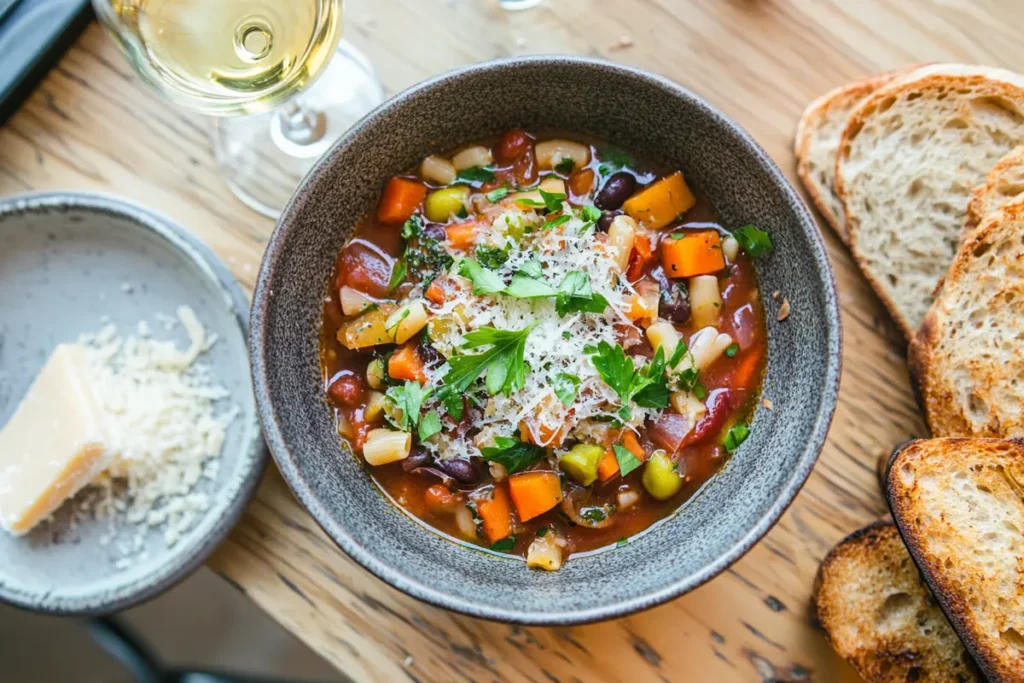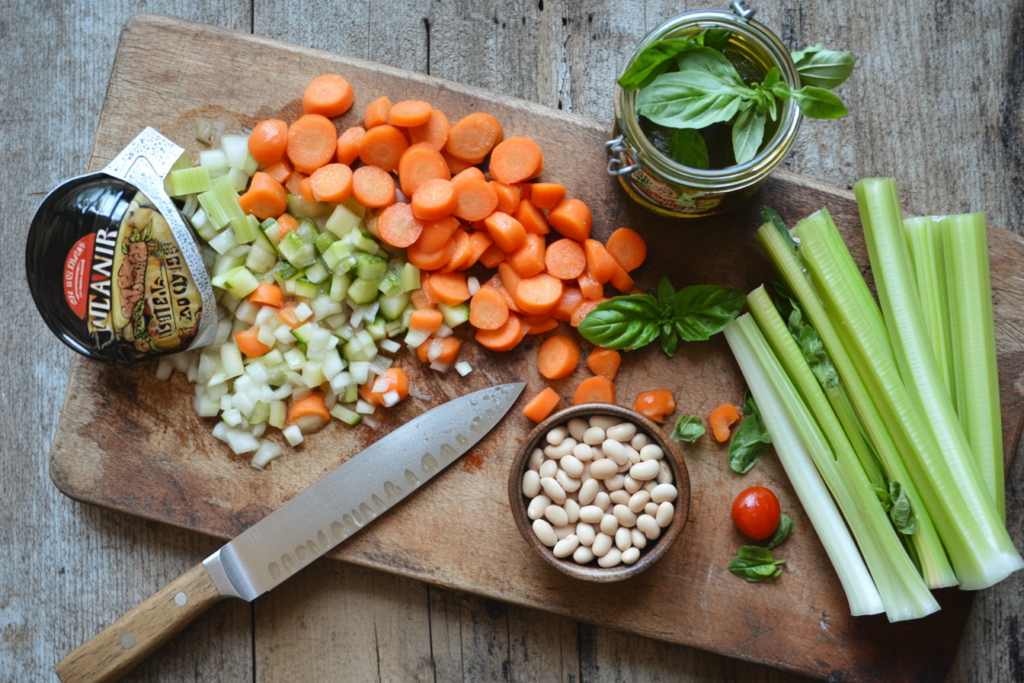Minestrone soup, a classic Italian dish, has stood the test of time as a comforting, hearty, and nutritious meal. Whether it’s a cold winter evening or a sunny summer afternoon, a bowl of minestrone offers flavors that are universally appealing. But what makes this soup so special? Why is minestrone soup so good? In this article, we’ll delve into its rich history, key ingredients, health benefits, and versatile nature that makes it a beloved dish worldwide.

The Origins
Minestrone soup has its roots in Italy, where it evolved as a “peasant dish” created to use up leftover vegetables and grains. Its name is derived from the Italian word minestra, meaning “soup” or “to serve.” Over centuries, minestrone has grown into a staple of Italian cuisine, symbolizing resourcefulness and community.
Why Is It So Good? The Key Factors
1. The Perfect Balance of Flavors
Minestrone soup combines a medley of fresh vegetables, herbs, and broth, resulting in a harmonious blend of flavors. Each spoonful delivers a mix of sweetness from carrots, earthiness from beans, and tanginess from tomatoes, all tied together with aromatic herbs like basil and oregano.
2. It’s Incredibly Versatile
Minestrone soup is an adaptable recipe that allows endless customization. You can tailor the soup to the season, using summer squash and fresh green beans in warmer months or hearty root vegetables in winter. Add pasta, rice, or even quinoa for variety.
3. Packed with Nutritional Goodness
The ingredients in minestrone soup provide a powerhouse of nutrients. It’s rich in fiber, vitamins, and minerals from vegetables, while legumes like cannellini beans add protein. This makes it not only delicious but also a healthy choice for any meal.
4. A Comforting Bowl of Warmth
There’s something inherently comforting about a steaming bowl of soup. Minestrone’s heartiness satisfies hunger while its warm, rich broth soothes the soul, making it a go-to comfort food.
Key Ingredients of Minestrone Soup

Every pot of minestrone soup is unique, but these ingredients are commonly found in most recipes:
1. Vegetables
- Carrots, celery, and onions: The holy trinity of soup bases.
- Tomatoes: Add acidity and depth.
- Zucchini, spinach, or kale: For seasonal freshness.
2. Beans
Cannellini beans, kidney beans, or chickpeas are staples, providing protein and texture.
3. Broth
A flavorful broth, whether vegetable or chicken, forms the foundation of the soup.
4. Pasta or Grains
Small pasta shapes, such as ditalini, or grains like farro or barley, add body and make the soup more filling.
5. Herbs and Spices
Classic Italian herbs like basil, thyme, and oregano give the soup its signature flavor.
Step-by-Step Guide to Making Minestrone Soup
Ingredients
- 2 tablespoons olive oil
- 1 onion, diced
- 2 carrots, sliced
- 2 celery stalks, diced
- 3 garlic cloves, minced
- 1 zucchini, diced
- 1 cup fresh spinach
- 1 can (15 oz) diced tomatoes
- 1 can (15 oz) cannellini beans, drained and rinsed
- 4 cups vegetable broth
- 1 cup small pasta or rice
- 1 teaspoon dried oregano
- 1 teaspoon dried basil
- Salt and pepper to taste
- Fresh parsley, for garnish
Instructions
- Sauté the Aromatics: Heat olive oil in a large pot over medium heat. Add onions, carrots, and celery, and cook until softened, about 5 minutes. Add garlic and sauté for another minute.
- Build the Base: Stir in zucchini and cook for 3-4 minutes. Add tomatoes, beans, and broth. Bring to a boil.
- Simmer the Soup: Reduce heat and let the soup simmer for 20-25 minutes.
- Cook the Pasta: Add pasta or rice and cook until tender, about 8-10 minutes.
- Add Spinach and Herbs: Stir in fresh spinach, oregano, and basil. Season with salt and pepper.
- Serve and Garnish: Ladle the soup into bowls and garnish with fresh parsley.
Health Benefits of Minestrone Soup
1. High in Fiber
The vegetables and legumes in minestrone are excellent sources of dietary fiber, aiding digestion and promoting gut health.
2. Low in Calories
Despite its hearty nature, minestrone is relatively low in calories, making it ideal for weight management.
3. Nutrient-Dense
Each ingredient contributes valuable nutrients. Tomatoes offer vitamin C and antioxidants, beans provide protein and iron, and leafy greens like spinach add calcium and potassium.
4. Heart-Healthy
Using olive oil and a vegetable-based broth keeps the soup low in saturated fat, supporting cardiovascular health.
5. Great for Meal Prep
Minestrone soup stores well, allowing you to enjoy its benefits throughout the week. Refrigerate for up to 5 days or freeze for 3 months.
Why Is Minestrone Soup So Good for Different Diets?
1. Vegetarian and Vegan-Friendly
By using vegetable broth and omitting cheese, minestrone easily becomes a vegan-friendly dish.
2. Gluten-Free Options
Swap regular pasta with gluten-free varieties or grains like rice to accommodate gluten-free diets.
3. Low-Carb Variations
For a low-carb version, omit pasta and replace starchy vegetables with zucchini noodles or cauliflower rice.
4. High-Protein Boost
Add extra beans, lentils, or a side of grilled chicken for those seeking more protein.
Pairing Suggestions for Minestrone Soup
1. Crusty Bread
A slice of rustic bread is perfect for soaking up the flavorful broth.
2. Side Salad
Pair with a fresh garden salad or Caesar salad for a well-rounded meal.
3. Wine
A light red wine, such as Chianti, or a crisp white, like Sauvignon Blanc, complements the soup’s flavors beautifully.
FAQs
1. Why Is Minestrone Soup So Good for Health?
Minestrone soup is nutrient-dense, high in fiber, and low in calories, making it an excellent choice for maintaining overall health.
2. Can I Make It Ahead of Time?
Yes! Minestrone soup is even better the next day as the flavors meld together. Store it in an airtight container in the refrigerator.
3. What Makes Minestrone Soup Unique?
Unlike other soups, minestrone is highly customizable. You can use virtually any combination of vegetables, beans, and grains to suit your taste.
4. Is It a Complete Meal?
Absolutely! It’s packed with vegetables, protein, and carbohydrates, making it a satisfying and balanced meal on its own.
5. Can I Freeze Minestrone Soup?
Yes, minestrone freezes well. For best results, cook the soup without pasta, then add cooked pasta when reheating.
Conclusion: Why Is Minestrone Soup So Good?
Minestrone soup is more than just a meal; it’s a celebration of wholesome ingredients, tradition, and versatility. Its perfect balance of flavors, nutritional benefits, and ability to adapt to dietary preferences make it a dish that truly stands out. Whether you’re cooking for a crowd or preparing meals for the week, this soup is a reliable choice that never disappoints. So, the next time you’re looking for something comforting, healthy, and delicious, whip up a pot of minestrone soup and savor its goodness.